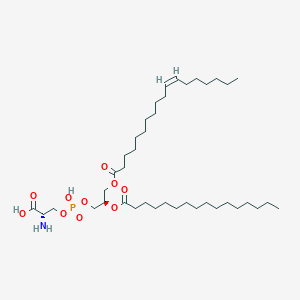| General Information of MET (ID: META00750) |
| Name |
PS(18:1(11Z)/16:0)
|
| Synonyms |
Click to Show/Hide Synonyms of This Metabolite
1-(11Z-Octadecenoyl)-2-hexadecanoyl-sn-glycero-3-phosphoserine; 1-Vaccenoyl-2-palmitoyl-sn-glycero-3-phosphoserine; PS(18:1(11Z)/16:0); PS(18:1/16:0); PS(34:1); Phosphatidylserine(18:1/16:0); Phosphatidylserine(34:1); pSer(18:1/16:0); pSer(34:1)
|
| Source |
Aliphatic acyclic compounds
|
| Structure Type |
Glycerophosphoserines (Click to Show/Hide the Complete Structure Type Hierarchy)
Lipids and lipid-like molecules
Glycerophospholipids
Glycerophosphoserines
|
| PubChem CID |
|
| HMDB ID |
|
| Formula |
C40H76NO10P
|
| Structure |
<iframe style="width: 300px; height: 300px;" frameborder="0" src="https://embed.molview.org/v1/?mode=balls&cid=131819694"></iframe>
|
 |
|
3D MOL is unavailable
|
2D MOL
|
|
Click to Show/Hide the Molecular/Functional Data (External Links/Property/Function) of This Metabolite
|
| Physicochemical Properties |
Molecular Weight |
762 |
Topological Polar Surface Area |
172 |
| XlogP |
10 |
Complexity |
947 |
| Heavy Atom Count |
52 |
Rotatable Bond Count |
41 |
| Hydrogen Bond Donor Count |
3 |
Hydrogen Bond Acceptor Count |
11 |
| Function |
PS(18:1(11Z)/16:0) is a phosphatidylserine (PS or GPSer). It is a glycerophospholipid in which a phosphorylserine moiety occupies a glycerol substitution site. As is the case with diacylglycerols, glycerophosphoserines can have many different combinations of fatty acids of varying lengths and saturation attached at the C-1 and C-2 positions. Fatty acids containing 16, 18 and 20 carbons are the most common. PS(18:1(11Z)/16:0), in particular, consists of one chain of vaccenic acid at the C-1 position and one chain of palmitic acid at the C-2 position. Phosphatidylserine is an acidic (anionic) phospholipid with three ionizable groups, i.e. the phosphate moiety, the amino group and the carboxyl function. As with other acidic lipids, it exists in nature in salt form, but it has a high propensity to chelate to calcium via the charged oxygen atoms of both the carboxyl and phosphate moieties, modifying the conformation of the polar head group. As phosphatidylserine is located entirely on the inner monolayer surface of the plasma membrane (and of other cellular membranes) and it is the most abundant anionic phospholipids. Therefore phosphatidylseriine may make the largest contribution to interfacial effects in membranes involving non-specific electrostatic interactions. This normal distribution is disturbed during platelet activation and cellular apoptosis. Phosphatidylserines typically carry a net charge of -1 at physiological pH. PS biosynthesis involves an exchange reaction of serine for ethanolamine in PE.
|
|
Regulatory Network
|
|
|
|
|
|
|
|
|
 click to show the details of this protein
click to show the details of this protein
 click to show the details of experiment for validating this pair
click to show the details of experiment for validating this pair

